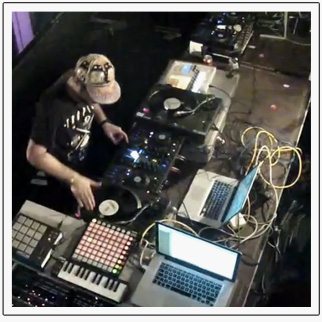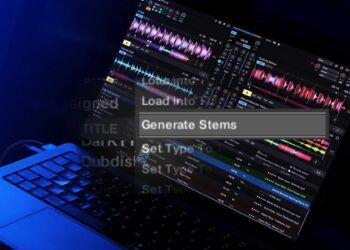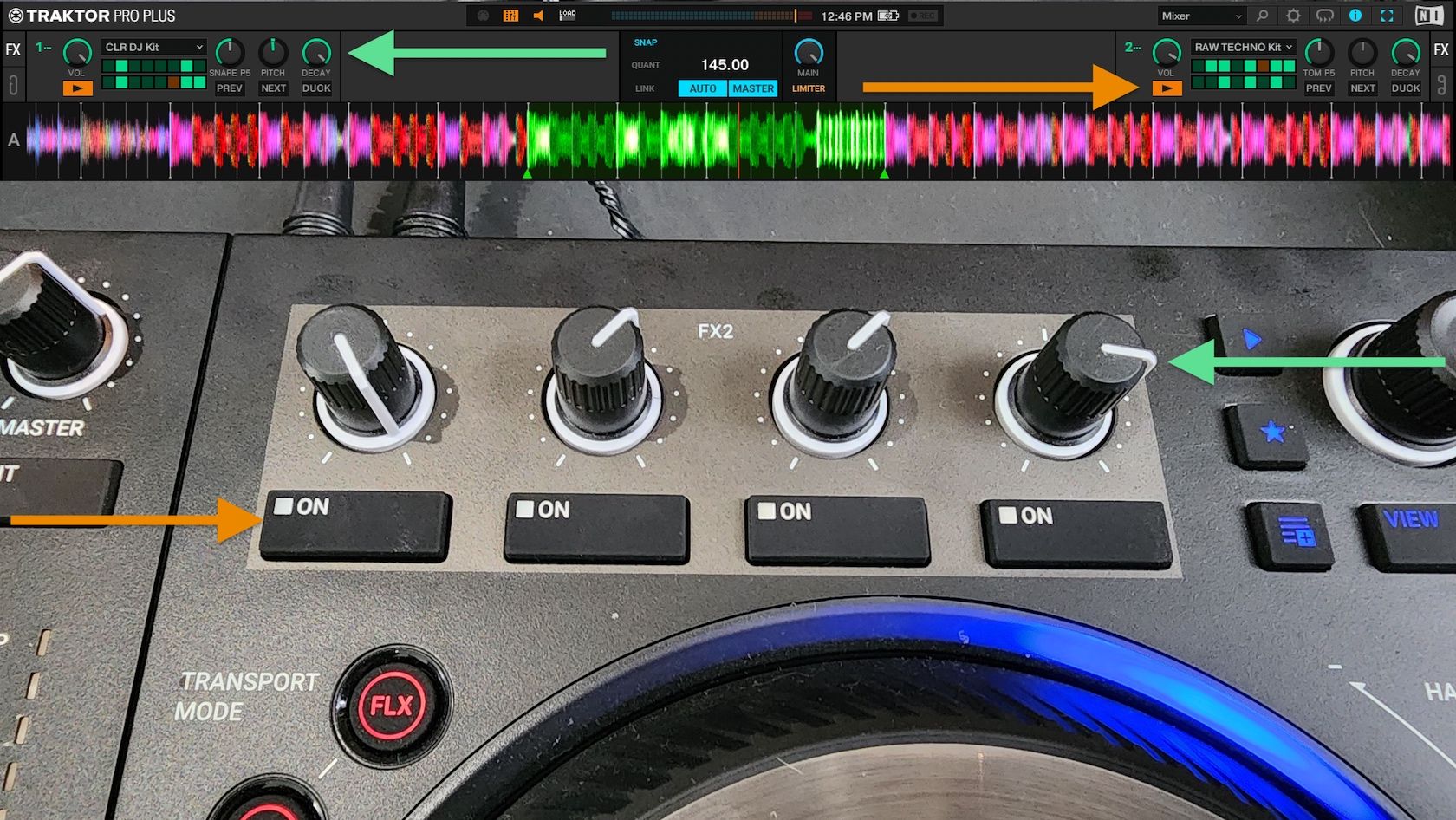When we opened this interview opportunity to our readers two weeks ago, we wanted to give you all a chance to ask the hard questions that were relevant and pressing, and we’re proud to call it a success. With help from Native Instruments, we were able to ask a bunch of your questions – and Tim, Jamie, Shiftee, Jeremy, Jimmy, Codec and Toby all delivered. Read on for their raw and unedited insight on performance styles, clever collaboration advice, technical routings explained, and more!
DJTT: Are you all just using improvisation or are there songs Mostly Robot has created to perform with? If you are improvising, how hard is it to work well with so many others when you do not know what’s going to be played next? Essentially, how does all this come together and not just sound like a hot mess?
TIM: Actually we’re not improvising all that much. We tried it a lot in the rehearsals, which was great fun for us but it always ended up being chaotic. We’re pretty much all one man bands as solo artists so we needed to come up with structures to know when to reign in and freak out.
JAMIE: We play a selection of original robot songs and a few hot covers. We are mostly robot after all so there’s not a lot of freestyle. The original songs are basically B-sides from the Lidell vault, the covers are from Aphex, Herbie Hancock and Mr. Smalls. There’s soloing that goes on but it’s all to a plan, too.. Van Halen knows when he’s playing in beat it after all.
Tim builds a lot of his sound in realtime using his crazy looper so that is improvised. A solution we had was to make complex “jams” a trio. When we do “Windowlicker” there’s just three of us working it out. Control vs Chaos!
SHIFTEE: It’s mostly all songs: remixes, covers, Jamie tunes, and a couple originals. If there’s improv, it’s within a concrete framework a la jazz. We tried jamming out a bit as a group, but working around definitive song structures proved to be the easiest way to manage the hot mess. The hot mess situation is also mitigated by people doing less than they are used to. One man bands are now one man mans.
JEREMY ELLIS: What Shiftee said.
MR JIMMY: Best way to make it not a hot mess is to listen to the other players. We definitely have songs or arrangements. All of our songs are vehicles for improvisation, collaboration, and expression both group and personal. We aren’t trying to step on each other, but to play together. My basslines wouldn’t be funky if they were clashing with the drums.
CODEC & TOBY: Speaking from the visual side, the skill of improvisation is essential. in regular VJ sets you usually don’t know what track is going to be next – you have to feel the transitions and adapt your visuals to the mood/tempo change of the music.
With Mostly Robot it’s a different story: improvisation is part of the songs themselves as there are certain solo parts which represent a musician in a visual way. We knew this in advance and switch between MIDI-triggered animations and hand-made improvisations.
DJTT: The Behind The Scenes Video covers a rough overview of what’s happening on stage. Everyone plays their role. What tips and advice do you have that may help (amateur) people to collaborate with other (amateur) people?
TIM: Listen, listen, listen… or in my case learn to listen, learn to listen, learn to listen. Depending on how used to playing together with others you might have to start there. You definitely need to plug into the hive mind and get comfortable with the fact that sometimes the outcome will be better if you do nothing.
JAMIE: Someone’s gotta be the boss…lol. Even if you decide that on a song by song basis, I think it really helps to have some kind of directorship. Making a feature film as a democratic effort would be a mess. It’s vital that there’s a sense of how each person fits into the whole. In traditional groups it’s easy coz one person’s on drums, another bass etc. With electronic music it’s not so easy! Roles can shift. My usual rule is: if it’s fun and making the air move right… trust it. If it’s too much “work” then something’s gotta give.
SHIFTEE: Thinking like a band really helps. One person plays 1-2 roles per song. The instruments might be electronic, but most rock bands don’t have each person playing 5-10 instruments at the same time. Also, I think it is crucial to be comfortable with your own tools before jumping in with others. Be willing to do less. Eat your vegetables.
JEREMY ELLIS: Less is more; almost always. Leave room for everyone else. In funk music, it’s called the pocket. Be the pocket. Advice for amateur musicians: For me, the best way to learn how to do anything is to learn how some genius before me did it. Learn a bunch of the greatest songs of all time, to your taste, and the good musical energy will sink in like osmosis. There are a million tricks to use, but generally you don’t want to be playing in the exact harmonic frequency range or rhythmic space as your fellow musicians. There are always exceptions, of course, and every rule is meant to be broken. So, maybe learn a bunch of the rules and then figure out how to break them effectively. Also, you’re going to want your band to look and smell good. When you’re practicing for a long time in close spaces, trust me, this is important. Seriously, I am not kidding.
MR JIMMY: You don’t need much. Use what you have – be it tools or people. Learn to lead if you have vision. Don’t make excuses. GET STARTED.
CODEC & TOBY:
1. gang together
2. listen to each other
3. keep in mind that it’s not about you but about the overall output.
4. don’t be afraid pushing an idea and don’t be disappointed when your idea doesn’t make it (see point above)
Editor’s Note: We’ve found the below video on YouTube that shows how Mostly Robot collaborated on one of their routines – moving around the group from performer to performer.
DJTT: Do any of you transcribe your songs/routines into a kind of sheet music/tablature, or do you record your parts and refer to them for consistency? Do you just remember the grooves from practice?
TIM: I just go down the remembering route… which doesn’t always work out!
JAMIE: It’s a memory thing for us I believe. I actually have a couple of notes on the laptop screen which helps during the show. I can glance at them quickly just to remember cues. That’s just coz we had a few days practice and the songs are new. In time it’d just flow..
SHIFTEE: Only a set list. Otherwise, it’s memory. Just like the noble elephant.
JEREMY ELLIS: Pure memory for me. I use a few notes and a set list on my laptop screen, as well.
MR JIMMY: We remember the grooves from practice. We are pros. That’s what we do. We could transcribe them a hundred different ways or analyze them and make them consistent and perfect. But we play together. We WANT it to be slightly different every time. YOU CAN’T QUANTIZE SEXY.
CODEC & TOBY: We have a grubby piece of paper from the hotel room where we sketch the visual scenes of the songs and their relating visual topics.
DJTT: What was everyone’s favorite part about the project?
TIM: Doing Windowlicker live. When I started making my own instruments years ago it was my dream to have the control and flexibility to be able to play Windowlicker live. So it’s a dream come true… I actually welled up the first few times we did it.
JAMIE: Taking on something so ambitious would only be possible with real heavy musicians and visualists. I loved the fact that in such a short space of time we managed to get a show together. Basically the players are the best thing! People!
SHIFTEE: The summer camp aspect of it. We worked on music, yes, but there was also lots of hangzones and tomfoolery (even though no one is named Tom in the group).
JEREMY ELLIS: The humans. Robots were a bit scary.
MR JIMMY: Hanging out with brilliant, nice, and charismatic people, and to feel like a peer. That goes for musicians, Pfadfinderei, and especially our NI managers.
CODEC & TOBY: Jamming together in a squash court.
And the distortion part in Windowlicker live – epically chaotic.
Editor’s Note: here’s the best video we’ve found online of their cover of Aphex Twin’s Windowlicker – NI promises that more official performance footage will be released eventually!
DJTT: Does anyone in the band us musicians earplugs or in-ear monitors? Why or why not?
TIM: No, just traditional wedges… I used in-ears on tour with Imogen Heap which was a much more scripted show so it made sense but it can be isolating. Earplugs are great for watching/listening but I can never get into the groove at -30dB so I suck up the damage I guess. My ears are holding out so far.
JAMIE: Not right now. It might actually be a good idea ! I just lost my in-ears… serious downer!
SHIFTEE: I don’t use earplugs when I play, because I feel it separates me a bit from the atmosphere of the room. Otherwise, I use musicians’ ear plugs when I’m not playing. I like to sit on the side drinking Shirley Temples, while listening at a comfortable volume.
JEREMY ELLIS: I really need to get some! In some ways, I do like to hear exactly what the audience is hearing, but mostly it’s been a case of not getting them because of laziness. Hearing loss runs in my family and I’ve been crazy lucky that it hasn’t effected me yet. Pointlessly loud music sucks though, IMO. There’s only so much the human ear can take and it’s not uncommon for me to have the sound person turn the music down. It’s quite rare, but there really are times when there is too much bass. I can’t believe I just typed that!
MR JIMMY: Nope. We will one day. We didn’t have enough time to assimilate that system into THEROBOT. In Spain we assimilated run of the mill MONITORRIG and PUBLICADDRESS systems instead. It’s all the same.
CODEC & TOBY: We are visual guys, we use sunglasses.
DJTT: Does anyone use a click track or metronome for keeping time during performance?
TIM: My system is locked into a grid as it uses loops so when I have the tempo banana then the other guys play to my grid by ear. Otherwise I do stuff that doesn’t involve loops.
JAMIE: Nope. We are on an unsteady eddie tip!
SHIFTEE: Mmmm no click tracks. Sometimes our main groove is locked to grid, spending on who is doing what (e.g. Tim playing main drums or me playing a break).
JEREMY ELLIS: No, but I practice to a metronome all the time. Ok, maybe not all the time. Let’s say a thousand times and quite a bit recently. Timing is everything!
MR JIMMY: Tim himself is on his own time clock, and sometimes Shiftee could play loops, but we listen. We listen to Tim if he’s the drums (Windowlicker) but everybody compensates. Including him. I’m sure he’s doing some tap tempos and whatnot over there. HIS INSTRUMENT IS VERY ESOTHERIC.
CODEC & TOBY: We use the duracell bunny.
DJTT: Jamie, you’ve got an amazingly clear voice – what would you think of Mostly Robot if it hadn’t any live vocals? (perhaps renaming the band For Sure It’s Robot?)
JAMIE: I joke that I’m the feminine force in the band. It MIGHT get kinda noisy without a song and vocal floating around. I’m pretty biased toward the vocal side of thing though!
DJTT: Do you use the Kontrol S4 and Kontrol F1 in Traktor, or did you do a custom MIDI mapping for both controllers in a software DAW like Ableton?
JAMIE: It was thanks to Shiftee’s expert programming skills that I exclusively use the S4 and F1 inside Traktor. It’s pretty sweet just turning up to the show and plugging right in with this simple template activated. Very quick to set up, very reliable and good latency for the vocal plus FX which is a real relief.
DJTT: This one’s for Codec & Toby. Native Instruments have recently been moving away from outputting MIDI for many of their controls, relying instead on HID connections to the software. What issues have you had getting MIDI from the NI instruments for your visuals, and do you foresee having to ask for special MIDI outputs from NI so you can continue to support their devices?
CODEC & TOBY: Since we play with DJs we were always curious about a turntable player with midi out to sync scratches with animations. With DJ Shiftee on board, we were desperate to find a solution for this. After a short meeting with Jim from NI they just integrated a scratch output into Traktor.
That’s a really fun feature.
DJTT: Can you explain your MIDI pipe from vinyl/control movement to Quartz Composer? Is it a MIDI out function from within Traktor or is it similar to the Serato Video Quartz modules?
CODEC & TOBY: Thanks to NI it’s a very flexible MIDI out of Traktor.

DJTT: For Tim: How do you keep an eye on what’s coming from which channel – what monitoring techniques/tools do you have?
TIM: The looper has LED meters from each loop and auto-mixed endless relative gain structure which keeps everything relatively in check. I spent a lot of time on the dynamic automixing side of the patch so it’s kind of like mixing on a board with elasticated faders… everything has a kind of stasis point relative to everything else in the mix. There’s no monitoring… what you hear from FOH is what I hear. It’s an instrument!
DJTT: The BCRs and BCF2000 still play a big roll in your set up. Are there still no new controllers on the market that could take their place?
TIM: I haven’t really looked hard TBH… I’ve been building a new setup for a couple of years which I hope to be finished some time by the end of this year/beginning of next which has a totally new approach to control. My current instrument’s integration with the BCR/BCFs is so tight that any replacement would need to have exactly the same layout and MIDI implementation. It’s an instrument and has a very specific feel!
DJTT: Do you know which effects you are going to play before you step onstage? Or is your role more improvisational?
TIM: For Mostly Robot I have a pretty good idea. In my own live sets it’s much more a matter of stepping up to an instrument and getting into a creative conversation with it using my vocab of techniques.
DJTT: Mr. Jimmy: Since you’re using FM8 and Razor, you’re definitely creating your own sounds. How many sounds did you create for the Mostly Robot performances and which one of these is your personal favorite? Any plans on making a tutorial on how to create this specific sound?
TIM: I probably made twenty or so sounds for MOSTLYROBOT mostly basses mostly brasses mostly pads. Mostly electric pianos.
I like the mostly lately bass best. JANETJACKSON y’ALL!!!
I am by no means the king of synthesis, I would defer to Jamie on that hang, but I just soundfarm for the kind of sound I want (FM 8 is real good on that front). I’ve imported lots of DX7 sysex banks and I’ll take a simple DX7 patch and freak it out with FM8 effects and easy editor mode. Turn knobs, you know. Take out release on a sound with the master envelope or make a brass pad into a stabbier sound by turning down attack on both the timbral and amplitude envelope. Same basic thing in Razor. Patch management is the real hang, and Native’s hangs are awesome on that tip.
I WILL MAKE A VIDEO SOON AND IT WILL INVOLVE SOUNDS, education, AND DUCKHUNTING.
DJTT: Jeremy- what do you think of arcade button controllers like the Midi Fighter? Do you use velocity detection extensively in your routines?
JEREMY: I played with some Midi Fighters the other day (at the DJ Techtools office, no less) and it was super fun. It really touches your inner child. Besides that, the DJ Techtools team is hella nice and came to my show that night! There are a few specific situations when I use velocity to switch between two samples programed to the same pad, but for the most part I turn the fixed (full) velocity setting on so my drums and samples come out consistently during performances. Another good reason to reason to turn of the velocity sensitivity is that you can then play the pads very lightly, so your fingers and hands don’t ache so much after you rock a crowd’s face off for an hour or more.
DJTT: What kind of a stand are you using for the Maschine?
JEREMY: I’m using 2 Crane DJ stands to keep my Maschines at a proper angle for my wrists and for the audience to view the pads. Since they bounce a bit too much, I got my friend Jesse Dean to make me a custom stand that’s basically a metal triangle that folds flat into my laptop bag. Kinda sweet! I use that one for my main Maschine.
DJTT: You mentioned how great the Maschine pads are in the video, do you modify your Akai pads to improve their sensitivity, or leave them stock?
JEREMY: I’ve never messed with my Akai pads, except to get them fixed on my MPC2000xl semi-monthy back in the day. BTW, back in the day was about four years ago. Disclaimer: I never broke the actual pads, but I’d do atomic elbow drops and knock some of the electrical stuff out of whack. My dude in Detroit would fix it in less than ten minutes and would charge me $20. Good deal! My MPD pads are in super bad shape, but that’s because I often finish shows by playing that thing with my feet. They’re pretty much unplayable, but I do like the faders so I still bring it to shows. And for the big finish.

DJTT: On to you, Shiftee. You link your timecodes with visuals via MIDI. Don’t you think it’s time Traktor incorporates video?
SHIFTEE: I agree this would be pretty, pretty, pretty, pretty good (Larry David Curb Your Enthusiasm voice). I will say from a DJ perspective, my main concern is always audio though.
DJTT: You’re nearly using a lot of NI hardware on your desk. Which of these devices would call the most powerful piece of hardware you’ve got on your Mostly Robot work desk?
SHIFTEE: Are you asking who would win in a battle royale to the death? The S4 has a lot of weight and size, but the Maschine has speed and technique at its disposal. I think Maschine could win the early rounds with its pad power, but the S4 would lay down a haymaker in the last round with its built-in sound card and MIDI-out robustness.
DJTT: With enough practice would you be able to do everything you do with the turntables with the S4 jog wheels? If not, what do you think the jog wheels are missing? And what are they adding?
SHIFTEE: No. Some advanced turntablism, especially in beat juggling, requires spinning platters. The spinning records allow you (1) to hit certain points faster than via a rewind and (2) to have immediate scratchability upon controlling the record. For me, the main thing the S4 jog wheels are missing is a spinning platter with torque. They are adding portability. A lot of maneuvers can be pulled on the S4 jog wheels, just not my full arsenal.
Thanks to all of the guys for taking time to answering every question we came up with, and to Constantin over at NI for coordinating the interview!




![jamie-and-jimmy-mostly-robot Photo Credit: Toni Rosado [toni@scannerfm.com]](https://s11234.pcdn.co/wp-content/uploads/2012/08/jamie-and-jimmy-mostly-robot.jpg)








